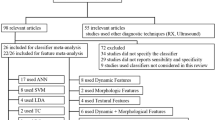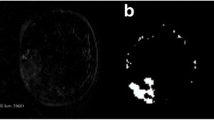Abstract
Dynamic contrast-enhanced (DCE)-magnetic resonance imaging (MRI) of the breast has emerged as an adjunct imaging tool to conventional X-ray mammography due to its high detection sensitivity. Despite the increasing use of breast DCE-MRI, specificity in distinguishing malignant from benign breast lesions is low, and interobserver variability in lesion classification is high. The novel contribution of this paper is in the definition of a new DCE-MRI descriptor that we call textural kinetics, which attempts to capture spatiotemporal changes in breast lesion texture in order to distinguish malignant from benign lesions. We qualitatively and quantitatively demonstrated on 41 breast DCE-MRI studies that textural kinetic features outperform signal intensity kinetics and lesion morphology features in distinguishing benign from malignant lesions. A probabilistic boosting tree (PBT) classifier in conjunction with textural kinetic descriptors yielded an accuracy of 90%, sensitivity of 95%, specificity of 82%, and an area under the curve (AUC) of 0.92. Graph embedding, used for qualitative visualization of a low-dimensional representation of the data, showed the best separation between benign and malignant lesions when using textural kinetic features. The PBT classifier results and trends were also corroborated via a support vector machine classifier which showed that textural kinetic features outperformed the morphological, static texture, and signal intensity kinetics descriptors. When textural kinetic attributes were combined with morphologic descriptors, the resulting PBT classifier yielded 89% accuracy, 99% sensitivity, 76% specificity, and an AUC of 0.91.








Similar content being viewed by others
Notes
Protected by PCT International Application No. PCT/US2009/034505.
References
Saslow D, Boetes C, Burke W, Harms S, Leach MO, Lehman CD, Morris E, Pisano E, Schnall M, Sener S, Smith RA, Warner E, Yaffe M, Andrews KS, Russell CA: American Cancer Society guidelines for breast screening with MRI as an adjunct to mammography. CA Cancer J Clin 57:75–89, 2007
Heywang-Kobrunner SH, Viehweg P, Hienig A, Kuchler C: Contrast-enhanced MRI of the breast: accuracy, value, controversies, solutions. Eur J Radiol 24:94–108, 1997
Sickles EA, Filly RA, Callen PA: Benign breast lesions: ultrasound detection and diagnosis. Radiology 151:467–470, 1984
Kuhl CK, Mielcareck P, Klaschik S, Leutner C, Wardelmann E, Gieske J, Schild HH: Dynamic breast MR imaging: are signal intensity time course data useful for differential diagnosis of enhancing lesions. Radiology 211:101–110, 1999
Piccoli CW: Contrast-enhanced breast MRI: factors affecting sensitivity and specificity. Eur Radiol 7(Suppl. 5):S281–S288, 1997
Nie K, Chen J-H, Yu HJ, Chu Y, Nalcioglu O, Su M-Y: Quantitative analysis of lesion morphology and texture features for diagnostic prediction in breast MRI. Acad Radiol 15:1513–1525, 2008
Ikeda DM, Hylton N, Kinkel K, Hochman MG, Kuhl C, Kaiser WA, Weinreb JC, Smazal SF, Degani H, Viehweg P, Barclay J, Schnall MD: Development, standardization, and testing of a lexicon for reporting contrast-enhanced breast magnetic resonance imaging. J Magn Reson Imaging 13:889–895, 2001
American College of Radiology (ACR): Breast imaging reporting and data system atlas (BIRADS Atlas). American College of Radiology, Reston, 2003
Kinkel K, Helbich TH, Esserman LJ, Barclay J, Schwerin E, Sickles EA, Hylton NM: Dynamic high-spatial-resolution MR imaging of suspicious breast lesion: diagnostic criteria and interobserver variability. AJR Am J Roentgenol 175(1):35–43, 2000
Schnall MD, Blume J, Bleumke DA, DeAngelis GA, DeBruhl N, Harms S, Heywang-Kobrunner SH, Hylton N, Kuhl C, Pisano ED, Causer P, Schnitt SJ, Thickman D, Stelling CB, Weatherall PT, Lehman C, Gastonis CA: Diagnostic architectural and dynamic features at breast MR imaging: multicenter study. Radiology 238(1):42–53, 2006
Li K-L, Henry R, Wilmes LJ, Gibbs J, Zhu X, Lu Y, Hylton NM: Kinetic assessment of breast tumors using high spatial resolution signal enhancement ratio (SER) imaging. Magn Reson Med 58(3):572–581, 2007
Kuhl C: MRI of breast tumors. Eur J Radiol 10:46–58, 2000
Chen W, Giger ML, Bick U, Newstead GM: Automatic identification and classification of characteristic kinetic curves of breast lesion on DCE-MRI. Med Phys 33(8):2878–2887, 2006
Stoutjesdijk MJ, Veltman J, Huisman H, Karssemeijer N, Barentsz JO, Blickman JG, Boetes C: Automated analysis of contrast enhancement in breast MRI lesions using mean shift clustering for ROI selection. J Magn Reson Imaging 26(3):606–614, 2007
Szabo BK, Aspelin P, Wiberg MK: Neural network approach to the segmentation and classification of dynamic magnetic resonance images of the breast: comparison with empiric and quantitative kinetic parameters. Acad Radiol 11:1344–1354, 2004
Twellmann T, Meyer-Baese A, Lange O, Foo S, Nattkemper TW: Model-free visualization of suspicious lesions in breast MRI based on supervised and unsupervised learning. Eng Appl Artif Intell 21:129–140, 2008
Zheng Y, Englander S, Baloch S, Zacharaki EI, Fan Y, Schnall MD, Shen D: STEP: spatiotemporal enhancement pattern for MR-based breast tumor diagnosis. Med Phys 37(7):3192–3204, 2009
Woods BJ, Clymer BD, Kurc T, Heverhagen JT, Stevens R, Orsdemir A, Bulan O, Knopp MV: Malignant-lesion segmentation using 4D co-occurrence texture analysis applied to dynamic contast-enhanced magnetic resonance breast image data. J Magn Reson Imaging 25:495–501, 2007
McLaren CE, Chen W-P, Nie K, Su M-Y: Prediction of malignant breast lesions from mri features: a comparison of artificial neural network and logistic regression techniques. Acad Radiol 16:842–851, 2009
Meinel LA, Stolpen AH, Berbaum KS, Fajardo LL, Reinhardt JM: Breast MRI lesion classification: improved performance of human readers with a backpropagation neural network computer-aided (CAD) system. J Magn Reson Imaging 25(1):89–95, 2007
Levman J, Leung T, Causer P, Plewes D, Martel AL: Classification of dynamic contast-enhanced magnetic resonance breast lesions by support vector mechines. IEEE Transact Med Imaging 27:688–696, 2008
Penn A, Thompson S, Brem R, Lehman C, Weatherall P, Schnall M, Newstead G, Conant E, Ascher S, Morris E, Pisano E: Morphologic blooming in breast MRI as a characterization of margin for discriminating benign from malignant lesions. Acad Radiol 13:1344–1354, 2006
Gibbs P, Turnbull LW: Texture analysis of contast-enhanced MR images of the breast. Magn Reson Med 50:92–98, 2003
Degani H, Gusis V, Weinstein D, Fields S, Strano S: Mapping pathophysiological features of breast tumors by MRI at high spatial resolution. Nat Med 3(7):780–782, 1997
Weinstein D, Strano S, Cohen P, Fields S, Gomori JM, Degani H: Breast fibroadenoma: mapping of pathophysiologic features with three-time-point, contrast-enhanced MR imaging—pilot study. Radiology 210(1):233–240, 1999
Hauth EAM, Jaeger H, Maderwald S, Muhler A, Kimmig R, Forsting M: Quantitative 2- and 3-dimensional analysis of pharmacokinetic model-derived variables for breast lesions in dynamic, contrast-enhanced MR mammography. Eur J Radiol 66(6):300–308, 2008
Tofts PS, Berowitz B, Schnall MD: Quantitative analysis of dynamic Gd-DTPA enhancement in breast tumors using a permeability model. Magn Reson Med 33:564–568, 1995
Martel AL: A fast method of generating pharmacokinetic maps from dynamic contrast-enhanced images of the breast. Int Conf Med Image Comput Comput Assist Interv 9(Pt 2):101–108, 2006
Vignati A, Giannini V, Bert A, Deluca M, Morra L, Persano D, Martincich L, Regge D: A fully automatic lesion detection method for DCE-MRI fat-suppressed breast images. Proceedings of SPIE Medical Imaging, 2009
Coto E, Grimm S, Bruckner S, Groller ME, Kanitsar A, Rodriguez O. MammoExplorer: an advanced CAD application for breast DCE-MRI. Proceedings of Vision, Modeling and Visualization, 2005
Veltman J, Stoutjesdijk M, Mann R, Huisman HJ, Barentsz JO, Blickman JG, Boetes C: Contrast-enhanced magnetic resonance imaging of the breast: the value of pharmacokinetic parameters derived from fast dynamic imaging during initial enhancement in classifying lesions. Eur Radiol 18(6):1123–1133, 2008
Madabhushi A, Udupa JK, Souza A: Generalized scale: theory, algorithms, and application to image inhomogeneity. Comput Vis Image Underst 101(2):100–121, 2006
Madabhushi A, Feldman M, Metaxas DN, Tomaszewski J, Chute D: Automated detection of prostate adenocarcinoma from high-resolution ex vivo MRI. IEEE Transact Med Imaging 24(12):1611–1625, 2005
Kruizinga P, Petkov N: Nonlinear operator for oriented texture. IEEE Transact Image Process 8(10):1395–1407, 1999
Haralick RM, Shanmugam K, Dinstein IH: Textural features for image classification. IEEE Transact Syst Man Cybernet 3(6):610–621, 1973
Tiwari P, Rosen M, Madabhushi A: Dimensionality reduction scheme for detection of prostate cancer from magnetic resonance spectroscopy (MRS). Med Phys 36(9):3927–3939, 2009
Shi J, Malik J: Normalized cuts and image segmentation. IEEE Transact Pattern Anal Mach Intel 22(8):888–905, 2000
Rorden C, Brett M: Stereotaxic display of brain lesions. Behav Neurol 12(4):191–200, 2000
Gabor D: Theory of communication. J Inst Elect Eng 93:429–457, 1946
Grigorescu S, Petkov N, Kruizinga P: Comparison of texture features based on gabor filters. IEEE Transact Image Process 11:1160–1167, 2002
Jain AK, Farrokhnia F: Unsupervised texture segmentation using Gabor filters. Proceedings IEEE International Conference on Systems, Man and Cybernetics, pp 14–19, 1990
Street WN, Wolberg WH, Mangasarian OL: Nuclear feature extraction for breast tumor diagnosis. IS&T/SPIE 1999 International Symposium on Electrical Imaging: Science and Technology, Vol. 1905, pp 861–70, 1993
Naik S, Doyle S, Feldman M, Tomaszewski J, Madabhushi A: Gland segmentation and computerized gleason grading of prostate histology by integrating low-, high-level and domain specific information. The Second International Workshop on Microscopic Image Analysis with Applications in Biology, 2007
Chapelle O, Haffner P, Vapnik V: Support vector machines for histogram-based image segmentation. IEEE Transact Neural Network 10:1055–1064, 1999
Lee G, Rodriguez C, Madabhushi A: Investigating the efficacy on nonlinear dimensionality reduction schemes in classifying gene and protein expression studies. IEEE/ACM Transact Comput Biol Bioinform 5:368–384, 2008
Cortes C, Vapnik V: Support-vector networks. Mach Learn 20(3):273–297, 1995
Freund Y, Schapire RE: A decision-theoretic generalization of on-line learning and an application to boosting. J Comput Syst Sci 55:119–139, 1997
Tu Z: Probabilistic boosting-tree: learning discriminative models for classification, recognition, and clustering. Proceedings of the Tenth IEEE International Conference on Computer Vision, Vol. 2, pp 1589–1596, 2005
Chen W, Giger M, Lan L, Bick U: Computerized interpretation of breast MRI: investigation of enhancement-variance dynamics. Med Phys 31:1076–1082, 2004
Unay D, Ekin A, Cetin M, Jasinschi R, Ercil A: Robustness of local binary patterns in brain MR image analysis. Proceedings of the 29th Annual International Conference of the IEEE EMBS, 2098–2101, 2007
Acknowledgments
This work was made possible via grants from the Wallace H. Coulter Foundation, New Jersey Commission on Cancer Research Pre-doctoral Fellowship (09-2407-CCR-EO), National Cancer Institute (R01CA136535-01, ARRA-NCI-3 R21CA127186-02S1, R21CA127186-01, and R03CA128081-01), the Society for Imaging Informatics in Medicine (SIIM), the Cancer Institute of New Jersey, and the Life Science Commercialization Award from Rutgers University. We would also like to thank Dominic Kabbabe and Diana Sobers for their help with the feature extraction.
Author information
Authors and Affiliations
Corresponding author
Rights and permissions
About this article
Cite this article
Agner, S.C., Soman, S., Libfeld, E. et al. Textural Kinetics: A Novel Dynamic Contrast-Enhanced (DCE)-MRI Feature for Breast Lesion Classification. J Digit Imaging 24, 446–463 (2011). https://doi.org/10.1007/s10278-010-9298-1
Published:
Issue Date:
DOI: https://doi.org/10.1007/s10278-010-9298-1




